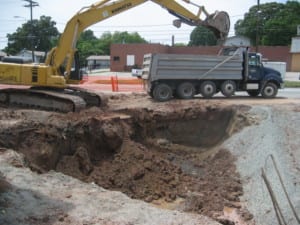 Our company has completed thousands of Environmental Site Assessments, which have ranged from simply reviewing the environmental history of a property and collecting a few samples to conducting extensive subsurface investigations at facilities over 100 acres in size.
Our company has completed thousands of Environmental Site Assessments, which have ranged from simply reviewing the environmental history of a property and collecting a few samples to conducting extensive subsurface investigations at facilities over 100 acres in size.
In many cases, the site assessments or investigations were initiated as a result of recent fuel or chemical spills and subsequent regulatory enforcement action. However, in other cases the investigations were initiated many years after clients had sold their commercial or industrial properties. In these cases, regulatory and civil action was initiated merely because the former owners were listed on the chain of title of a contaminated property and not necessarily because their action had caused contamination prior to sale.
The assessment, cleanup, and litigation costs associated with former properties exceed almost all of our other projects. In this article, you will learn how you can proactively use a Phase II Environmental Site Assessment (ESA) to protect your company from these post-sale liabilities.
How Environmental Liability Can Follow You (even if you’re not at fault)
The Comprehensive Environmental Response, Compensation, and Liability Act (CERCLA or Superfund) authorizes the U.S. Environmental Protection Agency (EPA) to respond to human health and environmental hazards posed by hazardous substances at properties. The courts have applied a strict liability standard under CERCLA. Liability is imposed regardless of fault and can be imposed retroactively (i.e., before CERCLA was enacted). The liability is also joint and several, meaning that liability can be imposed regardless of relative contribution.
Under CERCLA, the EPA can require liable parties to conduct cleanups, or the EPA can conduct a cleanup and subsequently seek cleanup cost recovery from liable parties. CERCLA defines a liable party as:
- the current owner and operator of a contaminated property;
- any owner or operator at the time of disposal of any hazardous substances;
- any person who arranged for the disposal or treatment of hazardous substances, or arranged for the transportation of hazardous substances for disposal or treatment;
- any person who accepts hazardous substances for transport to the property and selects the disposal site.
CERCLA concludes a person is an “owner or operator” of a facility (or property) if that person:
- owns or operates the facility; or
- owned, operated, or otherwise controlled activities at that facility immediately before title to the facility, or control of the facility, was conveyed to a state or local government due to bankruptcy, foreclosure, tax delinquency, abandonment, or similar means.
Example of a Former Property Owner’s Environmental Liability
Here is an example of how a client was found liable for environmental damages many years after the sale of a property, even though they may have had little or nothing to do with causing the contamination.
Company A owned several businesses at various locations. One location was a bit of an under-performer and Company A decided to sell this business location to a long-term employee who formed Company B. Company A wrote a clause into the sales contract that said Company B had the right to do an environmental inspection or otherwise obtained title “as is.” The long-term employee did not think it was necessary to spend the money for an Environmental Site Assessment.
Company B operated the business for several years, but since the business was under-capitalized, Company B put off maintenance and took a few “liberties” with on-site disposal of waste. Company B ended up going out of business and then the owner died. While Company B (and the associated business) was no longer viable, real estate was becoming very popular and the land became attractive for redevelopment.
The heirs of the owner of Company B received a purchase offer from Developer C. Developer C also did not conduct any type of Environmental Assessment on this “bargain” acquisition. Developer C began demolishing buildings and installing infrastructure. About this time, neighboring property owners began to detect contamination in their drinking water wells. The state environmental regulatory agency traced the contamination back to Developer C’s property and ordered Developer C to conduct an Environmental Site Assessment.
The Environmental Site Assessment revealed extensive soil and groundwater contamination. Developer C sued the heirs to Company B for selling a contaminated property. The heirs to the owner of Company B settled with Developer C by refunding what was left of the purchase price, but that was what remained of the estate.
Cleanup costs were going to far exceed the value of the property, so Developer C then pursued Company A for damages. Developer C claimed that former employees recalled contamination issues back when Company A owned the property. Company A prevailed in the civil suit with Developer C, who subsequently filed for bankruptcy.
The state environmental regulatory agency then commenced an enforcement action against Company A. Company A was compelled to conduct an assessment and cleanup of their former property, even though they no longer had title to the land. The environmental agency prevailed in their action because Company A could not prove that they had not assigned existing contamination to Company B.
How to Use a Phase II Environmental Site Assessment to Avoid Future Environmental Liability
In 2002, Congress passed the “Small Business Liability Relief and Brownfields Revitalization Act” (Brownfields Amendments). These amendments created a new landowner liability protection from CERCLA. The All Appropriate Inquiry Rule in the Brownfields Amendments provides an escape from liability called the “innocent landowner defense,” but this defense can only be used to escape liability if “appropriate due diligence” was conducted prior to the acquisition of the property.
CERCLA allows that “appropriate due diligence” has been exercised only if a thorough investigation of the site’s current and former uses has been prepared. This investigation is known as an Environmental Site Assessment.
The Environmental Site Assessment process starts with what is referred to as a Phase I Environmental Site Assessment. A Phase I Environmental Site Assessment (sometimes called a Phase I ESA or just a Phase I) is a prescribed method of inspecting a property and investigating its history in an effort to uncover potential environmental issues—known as Recognized Environmental Conditions (RECs). A REC is defined as the presence or likely presence of any hazardous substances or petroleum products in, on, or at a property. A REC doesn’t necessarily mean that there is contamination, just that contamination is possible.
Once a REC is identified in a Phase I ESA, a Phase II ESA may be recommended to evaluate the RECs by using sampling data to confirm the presence or threat of a release to the environment.
In the example explained above of the former property owner’s liability, had Company A performed a Phase II ESA and conducted sampling of the potential RECs, any minor contaminants could have been addressed long before they spread off-site. More importantly, Company A would have had baseline data to prove they did not try to assign existing environmental liability to Company B and would not have been liable for contamination caused by Company B.
More Information
If you are selling or purchasing a property, or would just like to know if your property is in compliance with state and Federal environmental regulations, contact Ambipar Response EMS to learn more about how we can help you with your Phase I and Phase II Environmental Site Assessment needs.
If you would like to read more about Environmental Site Assessments, check out these articles:
How Much Does a Phase I Environmental Site Assessment Cost?
How Much Does a Phase II Environmental Site Assessment Cost?
Is a Phase I ESA Necessary for Every Commercial Property Purchase?
Top 5 Reasons Banks Require Phase I Environmental Site Assessments




I didn’t know that the CERCLA authorizes the EPA to respond to human health and environmental hazards. It would be bad to be liable for any damages that could happen. I can see why having an environmental assessment would be valuable. You wouldn’t want anything like that to happen on your property! Thanks for the information!
Allan, I thought your post had a lot of good information on environmental site evaluations. I can see why it’s beneficial for property sellers to have this done. It sounds essential after reading how ESA helps you become aware of if you’re in compliance with state and federal environmental regulations.